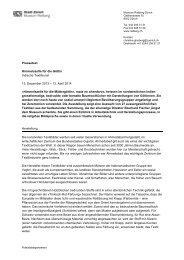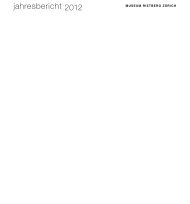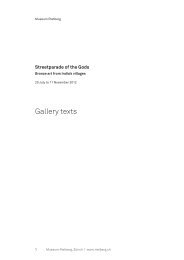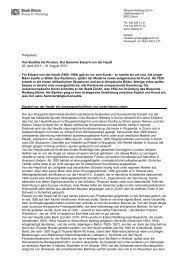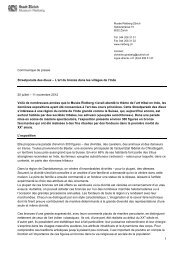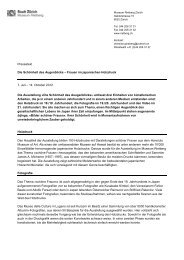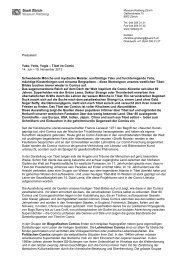1.1 eduard von der heydt - Museum Rietberg
1.1 eduard von der heydt - Museum Rietberg
1.1 eduard von der heydt - Museum Rietberg
You also want an ePaper? Increase the reach of your titles
YUMPU automatically turns print PDFs into web optimized ePapers that Google loves.
1.4<br />
«ars una»:<br />
das sammlungskonzept<br />
<strong>von</strong> <strong>der</strong> <strong>heydt</strong>s<br />
Kein an<strong>der</strong>er Sammler hat in seiner Zeit in<br />
einer solchen Vielfalt gesammelt wie Eduard <strong>von</strong> <strong>der</strong> Heydt:<br />
Werke aus Japan, China, Indien, Papua-Neuguinea, Kamerun,<br />
Kongo – und daneben Bil<strong>der</strong> <strong>von</strong> Cézanne, van Gogh, Picasso.<br />
Das Prinzip, auf dem diese breite Sammelleidenschaft<br />
beruhte, nannte er «ars una» – es gibt nur eine<br />
Kunst. Er selbst entschied, was Kunst war, und er fand sie<br />
überall, auf allen Kontinenten und in allen Jahrhun<strong>der</strong>ten.<br />
Dabei bevorzugte er Werke, die Ruhe und Erhabenheit ausstrahlten,<br />
in denen er Schönheit vorfand und eine schöpferische<br />
Kraft spürte. Darstellungen des Menschen, sein Antlitz<br />
und seinen Körper, sowie Darstellungen <strong>von</strong> Göttern und<br />
Ahnen favorisierte er. Dekoratives und Ornamentales interessierte<br />
ihn wenig.<br />
1.4<br />
“ars una” :<br />
the principle of the<br />
collection<br />
of <strong>von</strong> <strong>der</strong> <strong>heydt</strong><br />
1.4<br />
«ars una» :<br />
le concept de<br />
la collection de<br />
<strong>von</strong> <strong>der</strong> <strong>heydt</strong><br />
Aucun autre collectionneur de l’époque n’a<br />
rassemblé des œuvres d’une telle diversité: Eduard <strong>von</strong> <strong>der</strong><br />
Heydt achète de l’art du Japon et de la Chine, de l’Inde, de la<br />
Papouasie-Nouvelle-Guinée, du Cameroun, du Congo – mais<br />
aussi des tableaux de Cézanne, de van Gogh et de Picasso.<br />
Cette passion sans borne qui l’anime se fonde<br />
sur un principe qu’il appelle l’«ars una» – il n’existe qu’un seul<br />
art. Von <strong>der</strong> Heydt décidait lui-même ce qui était de l’art et en<br />
trouvait partout, sur tous les continents et à chaque siècle.<br />
Toutefois, il privilégiait des œuvres d’une grande majesté et<br />
respirant la sérénité, d’une beauté immanente, et dont il<br />
sentait émaner une force créatrice. Il marquait une préférence<br />
pour la figure humaine, les visages et les corps, ainsi<br />
que pour les représentations de divinités et d’ancêtres. L’art<br />
décoratif ou purement ornemental ne l’intéressait guère.<br />
No other collector at this time collected in<br />
such variety as Eduard <strong>von</strong> <strong>der</strong> Heydt: works from Japan,<br />
China, India, New Guinea, Cameroon, Congo – and paintings<br />
by Cézanne, van Gogh and Picasso.<br />
He called the principle on which this expansive<br />
love of collecting was based “ars una” – there is only one<br />
art. He himself decided what was art, and he found it everywhere,<br />
in every century, on every continent. He favoured<br />
works which emanated calm and grandeur, works in which he<br />
found beauty and creative power. He usually preferred representations<br />
of humans, of their faces and bodies, as well as<br />
depictions of gods and ancestors. Art that was purely decorative<br />
or ornamental did not interest him very much.<br />
Eduard <strong>von</strong> <strong>der</strong> Heydt in / à Zandvoort, 1933 (bpk / Erich Salomon)<br />
Zandvoort, Heiliger Georg mit zwei Grabfiguren aus dem Kongo<br />
(Saint George with two Kongolese grave figures / Saint-Georges<br />
et deux statuettes funéraires congolaises), 1933 (bpk / Erich Salomon)






